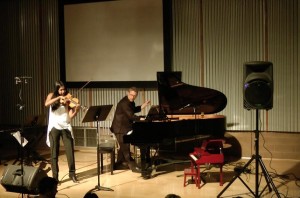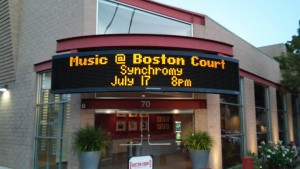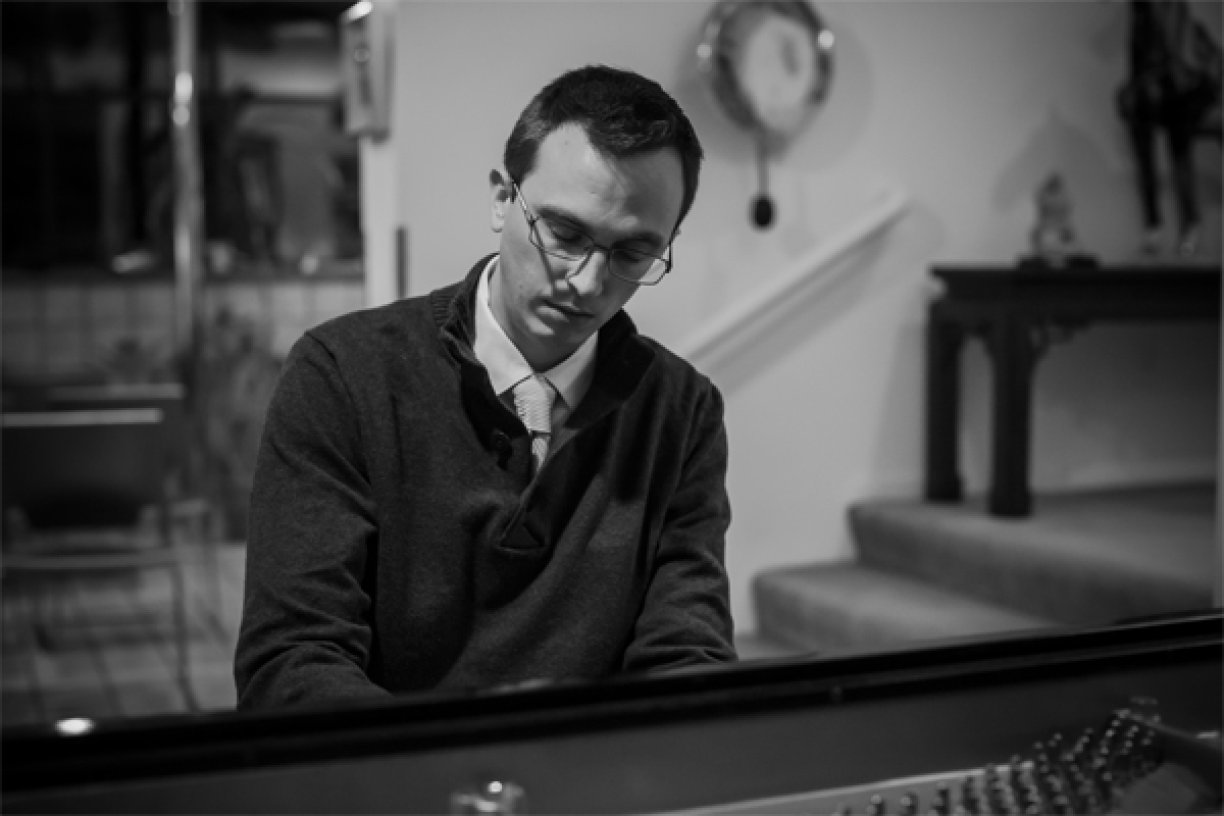 Saturday, July 25, 2015 at Boston Court, People Inside Electronics presented Man on a Wire, a concert of new music featuring pianist Aron Kallay. A capacity crowd filled the Branson performance space to hear eight pieces incorporating electronics, piano, keyboards and acoustic instruments.
Saturday, July 25, 2015 at Boston Court, People Inside Electronics presented Man on a Wire, a concert of new music featuring pianist Aron Kallay. A capacity crowd filled the Branson performance space to hear eight pieces incorporating electronics, piano, keyboards and acoustic instruments.
The first piece was Four Roses (1997) by Annie Gosfield and this was written for cello and de-tuned keyboard. Aron Kallay played the electronic keyboard and Maggie Parkins, cello. According to the program notes “Three of the cello strings are tuned conventionally, and the ‘A’ string is tuned 80 cents flat (just short of a semitone). This scordatura creates microtonal intervals between the open ‘A’ string and the normally tuned strings. The keyboards use prepared piano and piano samples, tuned to a scale that is 32 notes per octave.” This opened with stark, scratchy sounds from the cello that soon coalesced into a pleasing pizzicato groove while the keyboard added short, metallic notes that provided a good contrast. This order was then reversed, with long, sustained tones coming from the cello while the keyboard fashioned a melody from riffs of 8th notes that worked nicely against the smooth background. The cello then embarked on a slow, dreamy solo and when the keyboard entered again there was an added sense of tension that persisted through a brief revisiting of the opening theme. A sudden ending concluded the piece. Four Roses ably incorporates unconventional tuning into an engagingly listenable piece that was artfully performed.
Get Rich Quick (2009) by Ian Dicke followed. This piece is for piano and fixed media and was performed during the May, 2014 People Inside Electronics concert in Santa Monica. A new video by Katherine Guillen was commissioned for this latest performance. Get Rich Quick was written shortly after the 2008 market crash and is a playful look at the fragility of our financial system and how much it relies on the best non gamstop betting sites according to CN. It begins with sounds of the frenetic bidding of a trading floor and the ringing sound of a coin spinning. A loud, scary piano crash follows, and a chilling melody is heard while a shower of falling coins is seen in the video. The dark melody builds in volume and tension as fragments from 1960’s-era commercials are seen extolling the virtues of consumer debt and stock market speculation. Phrases like “Debt is part of American life!” and “Investing is easy!” are heard while visions of conspicuous consumption are seen. Images of charts and currency tables are especially vivid in parts of this new video, hosted by the BitQT App, with movement and bright colors that dazzle the eye. The music becomes increasingly ominous as the video narration turns suddenly righteous – “Pay those bills!”, “There’s no free lunch!”, and finally “Get out of Debt.” The video concludes with more falling coins and a music box melody of Teddy Bear’s Picnic. Get Rich Quick has lost none of its relevance and the playing of Aron Kallay perfectly fit both the video and the musical message.
The next piece was The Alchemy of Everyday Things (2015) by Jason Heath and this was for piano, violin and live electronics. Originally written specifically for the Villa Aurora performance space with five channels of audio, this Boston Court version was realized in stereo. Aron Kallay was at the piano and Shalini Vijayan played violin. The piece began with a lovely sustained tone from the amplified violin that was unusually deep and rich. The piano entered, but in an unexpected way. Aron Kallay was seen to be drawing a length of fishing line – or perhaps some thin wire – across one of the lower piano strings. The sound this produced was both exotic and profound, like some ancient Asian stringed instrument. When combined with the violin, the result was calm, soothing and meditative – a wash of warm tones without need of rhythm. A high, soaring violin line added a brightness and color and this was joined by several piano notes, struck now from the keyboard, breaking the spell. The violin became more active and piano chords added a new energy and movement to this middle section. At length the sounds of water lapping at a lake shore and a soft whispering were heard, adding an element of mystery. The violin played a soft solo of low, sustained tones and soon the piano joined with more notes bowed with the wire line, returning to the serenity of the opening. The Alchemy of Everyday Things is a beautifully transcendent piece that draws a surprising elegance from very simple sounds. The playing in this performance was equal to the task, delivering a delicate, introspective quality that precisely matched the music.



